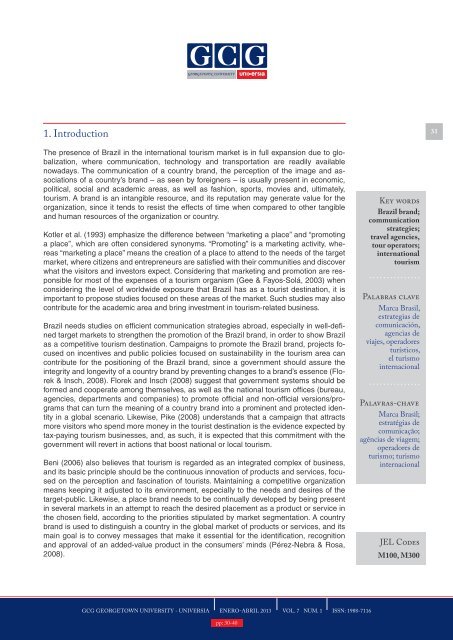The Communication Strategies for the Brazil Brand in the ... - Universia
The Communication Strategies for the Brazil Brand in the ... - Universia
The Communication Strategies for the Brazil Brand in the ... - Universia
Create successful ePaper yourself
Turn your PDF publications into a flip-book with our unique Google optimized e-Paper software.
1. Introduction<br />
31<br />
<strong>The</strong> presence of <strong>Brazil</strong> <strong>in</strong> <strong>the</strong> <strong>in</strong>ternational tourism market is <strong>in</strong> full expansion due to globalization,<br />
where communication, technology and transportation are readily available<br />
nowadays. <strong>The</strong> communication of a country brand, <strong>the</strong> perception of <strong>the</strong> image and associations<br />
of a country’s brand – as seen by <strong>for</strong>eigners – is usually present <strong>in</strong> economic,<br />
political, social and academic areas, as well as fashion, sports, movies and, ultimately,<br />
tourism. A brand is an <strong>in</strong>tangible resource, and its reputation may generate value <strong>for</strong> <strong>the</strong><br />
organization, s<strong>in</strong>ce it tends to resist <strong>the</strong> effects of time when compared to o<strong>the</strong>r tangible<br />
and human resources of <strong>the</strong> organization or country.<br />
Kotler et al. (1993) emphasize <strong>the</strong> difference between “market<strong>in</strong>g a place” and “promot<strong>in</strong>g<br />
a place”, which are often considered synonyms. “Promot<strong>in</strong>g” is a market<strong>in</strong>g activity, whereas<br />
“market<strong>in</strong>g a place” means <strong>the</strong> creation of a place to attend to <strong>the</strong> needs of <strong>the</strong> target<br />
market, where citizens and entrepreneurs are satisfied with <strong>the</strong>ir communities and discover<br />
what <strong>the</strong> visitors and <strong>in</strong>vestors expect. Consider<strong>in</strong>g that market<strong>in</strong>g and promotion are responsible<br />
<strong>for</strong> most of <strong>the</strong> expenses of a tourism organism (Gee & Fayos-Solá, 2003) when<br />
consider<strong>in</strong>g <strong>the</strong> level of worldwide exposure that <strong>Brazil</strong> has as a tourist dest<strong>in</strong>ation, it is<br />
important to propose studies focused on <strong>the</strong>se areas of <strong>the</strong> market. Such studies may also<br />
contribute <strong>for</strong> <strong>the</strong> academic area and br<strong>in</strong>g <strong>in</strong>vestment <strong>in</strong> tourism-related bus<strong>in</strong>ess.<br />
<strong>Brazil</strong> needs studies on efficient communication strategies abroad, especially <strong>in</strong> well-def<strong>in</strong>ed<br />
target markets to streng<strong>the</strong>n <strong>the</strong> promotion of <strong>the</strong> <strong>Brazil</strong> brand, <strong>in</strong> order to show <strong>Brazil</strong><br />
as a competitive tourism dest<strong>in</strong>ation. Campaigns to promote <strong>the</strong> <strong>Brazil</strong> brand, projects focused<br />
on <strong>in</strong>centives and public policies focused on susta<strong>in</strong>ability <strong>in</strong> <strong>the</strong> tourism area can<br />
contribute <strong>for</strong> <strong>the</strong> position<strong>in</strong>g of <strong>the</strong> <strong>Brazil</strong> brand, s<strong>in</strong>ce a government should assure <strong>the</strong><br />
<strong>in</strong>tegrity and longevity of a country brand by prevent<strong>in</strong>g changes to a brand’s essence (Florek<br />
& Insch, 2008). Florek and Insch (2008) suggest that government systems should be<br />
<strong>for</strong>med and cooperate among <strong>the</strong>mselves, as well as <strong>the</strong> national tourism offices (bureau,<br />
agencies, departments and companies) to promote official and non-official versions/programs<br />
that can turn <strong>the</strong> mean<strong>in</strong>g of a country brand <strong>in</strong>to a prom<strong>in</strong>ent and protected identity<br />
<strong>in</strong> a global scenario. Likewise, Pike (2008) understands that a campaign that attracts<br />
more visitors who spend more money <strong>in</strong> <strong>the</strong> tourist dest<strong>in</strong>ation is <strong>the</strong> evidence expected by<br />
tax-pay<strong>in</strong>g tourism bus<strong>in</strong>esses, and, as such, it is expected that this commitment with <strong>the</strong><br />
government will revert <strong>in</strong> actions that boost national or local tourism.<br />
Beni (2006) also believes that tourism is regarded as an <strong>in</strong>tegrated complex of bus<strong>in</strong>ess,<br />
and its basic pr<strong>in</strong>ciple should be <strong>the</strong> cont<strong>in</strong>uous <strong>in</strong>novation of products and services, focused<br />
on <strong>the</strong> perception and fasc<strong>in</strong>ation of tourists. Ma<strong>in</strong>ta<strong>in</strong><strong>in</strong>g a competitive organization<br />
means keep<strong>in</strong>g it adjusted to its environment, especially to <strong>the</strong> needs and desires of <strong>the</strong><br />
target-public. Likewise, a place brand needs to be cont<strong>in</strong>ually developed by be<strong>in</strong>g present<br />
<strong>in</strong> several markets <strong>in</strong> an attempt to reach <strong>the</strong> desired placement as a product or service <strong>in</strong><br />
<strong>the</strong> chosen field, accord<strong>in</strong>g to <strong>the</strong> priorities stipulated by market segmentation. A country<br />
brand is used to dist<strong>in</strong>guish a country <strong>in</strong> <strong>the</strong> global market of products or services, and its<br />
ma<strong>in</strong> goal is to convey messages that make it essential <strong>for</strong> <strong>the</strong> identification, recognition<br />
and approval of an added-value product <strong>in</strong> <strong>the</strong> consumers’ m<strong>in</strong>ds (Pérez-Nebra & Rosa,<br />
2008).<br />
Key words<br />
<strong>Brazil</strong> brand;<br />
communication<br />
strategies;<br />
travel agencies,<br />
tour operators;<br />
<strong>in</strong>ternational<br />
tourism<br />
Palabras clave<br />
Marca Brasil,<br />
estrategias de<br />
comunicación,<br />
agencias de<br />
viajes, operadores<br />
turísticos,<br />
el turismo<br />
<strong>in</strong>ternacional<br />
Palavras-chave<br />
Marca Brasil;<br />
estratégias de<br />
comunicação;<br />
agências de viagem;<br />
operadores de<br />
turismo; turismo<br />
<strong>in</strong>ternacional<br />
JEL Codes<br />
M100, M300<br />
GCG GEORGETOWN UNIVERSITY - UNIVERSIA ENERO-ABRIL 2013 VOL. 7 NUM. 1 ISSN: 1988-7116<br />
pp: 30-40















